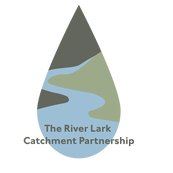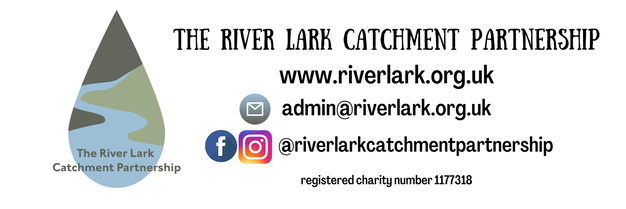Some names, links and descriptions that regularly pop up at RLCP meetings and events!
Abrasion - the pebbles being transported wear away the bed and banks of the river channel.
Abstraction - taking water from rivers or the aquifer to supply homes, farms, industry.
Alluvium - rock particles (clay, silt, sand and gravel) deposited by a river.
Aquifer - A subsurface layer or layers of rock or other geological strata of sufficient porosity and permeability to allow either a significant flow of groundwater or the abstraction of significant quantities of groundwater.
Attrition -rock particles are knocked about as they are transported, and they gradually become more rounded and reduced in size.
Backwater - A small, generally shallow body of water attached to the main channel with little or no current of its own pushed back by a dam or current.
Bar - An accumulation of alluvium (gravel or sand) caused by a decrease in water velocity.
Bedload - the material carried by a river by being bounced or rolled along its bed.
Biodiversity - the diversity of living species including animals, plants and their habitats.
Buffer zone - A strip of land adjacent to a watercourse that is protected, often with fencing, from impacts such as paving, livestock and grazing.
CaBA - The Catchment Based Approach (CaBA) is an inclusive, civil society-led initiative that works in partnership with Government, Local Authorities, Water Companies, businesses and more, to maximise the natural value of our environment.
CaBA partnerships are actively working in all 100+ river catchments across England and cross-border with Wales, directly supporting achievement of many of the targets under the Government’s 25 Year Environment Plan.
CaBA partnerships are actively working in all 100+ river catchments across England and cross-border with Wales, directly supporting achievement of many of the targets under the Government’s 25 Year Environment Plan.
CamEO - The Cam and Ely Ouse Catchment Partnership The scope of CamEO encompasses 5 river catchments; the River Lark, Little Ouse and Thet, Cam, Wissey, and South Level in the East of England. Together, these basins are operationally known as the CamEO partnership, which is co-hosted by The Rivers Trust and Anglian Water.
http://www.cameopartnership.org/who-we-are/
http://www.cameopartnership.org/who-we-are/
CaSTCo - (Catchment Systems Thinking Cooperative) is a 3-year Ofwat innovation project involving 24 partner organisations. It is a collaborative project to co-create a national framework focussed on citizen science and low-cost monitoring to generate a body of evidence regarding catchment health.
Catchment - The area of land that feeds rainwater to a river
Confluence - the point at which rivers meet.
CSF - Catchment Sensitive Farming raises awareness of diffuse pollution from agriculture by giving free training and advice to farmers in selected areas in England. The aim of the advice is to improve the environmental performance of farms.
CSO - Combined Sewer Overflow - a term used to describe what happens when combined sewer systems become overwhelmed by excess stormwater and overflow into nearby streams and rivers.
Culvert - A closed conduit carrying a watercourse beneath and obstruction such as a road, railway or canal.
Diffuse pollution - Pollution from widespread activities with no one discrete source, e.g. pesticides, urban run-off etc. Pollution resulting from scattering or dispersed sources that are collectively significant but to which effects are difficult to attribute individually
Dissolved Oxygen - A measure of the amount of oxygen in the water. Concentration is the measure of the amount of oxygen in a volume of water. Saturation is a measurement of the amount of oxygen in the water compared to the amount of oxygen the water can actually hold at full saturation.
DWMPs - Drainage and Wastewater Management Plans
EFI - Environmental Flow Indicator is used to indicate where abstraction, or flow regulation may start to have an undesirable impact on river habitats and species.
ELMs - Environmental Land Management schemes - there are three new schemes that will reward Environmental Land Management: sustainable farming initiative, local nature recovery and landscape recovery. Through these schemes, farmers and other land managers may enter into agreements to be paid for delivering environmental improvements.
Embankment - A bank of earth or stone that prevents the land behind from flooding.
Emergent - Rooted plants that can tolerate flooded soil but not extended periods of being completely submerged.
Ephemeral Stream - A stream that flows only in direct response to precipitation and whose channel is at all times above the water table. Ephemeral streams are short-lived, existing only after heavy rainfalls and drying up in between.
Eutrophication - high nitrate levels combined with phosphates cause excessive plant and algae growth, a deteriorating process that results in loss of oxygen and the biological death of the river.
Floodplain - Area of land bordering a river that is prone to flooding.
Groundwater - water in the chalk aquifer, which feeds the chalk stream.
Hydromorphology - Hydromorphology describes the characteristics of a water body. Hydrology refers to the flow and quantity of water. Geomorphology refers to the physical elements and processes of waterbodies such as lakes, rivers and coasts.
INNS - Invasive non-native species
Lateral connectivity - the connection between the river, its riparian margins and the flood plain.
LNRS - Local Nature Recovery Strategies are a flagship measure in the Environment Bill. They are a new system of spatial strategies for nature which will plan, map, and help drive more coordinated, practical, focussed action and investment in nature's recovery to build the national Nature Recovery Network.
Longitudinal connectivity - the connectedness along the linear length of the river, interrupted by artificial structures and barriers to fish migration, such as weirs.
Macrophytes - Larger plants, typically including flowering plants, mosses and larger algae but not including single-celled phytoplankton or diatoms.
NbS - Nature-based solutions involve working with nature to address societal challenges, providing benefits for both human well-being and biodiversity.
NE - Natural England
Non-Point Source (NPS) Pollution - Pollution originating in the watershed, often entering the waterbody via surface runoff or groundwater. Pollution that does not originate from a clean or discrete source.
NRN - Nature Recovery Network is a commitment in the government's 25-year Environment Plan and part of the forthcoming Nature Strategy. It will be a national network of wildlife-rich places. The aim is to expand, improve and connect these places across the country.
NWEBS - National Water Environment Benefit Survey
Perennial Stream - A stream that normally flows year-round because it lies at or below the ground water table, which constantly replenishes it.
Point Source Pollution - Pollution arising from an identifiable and discrete source such as a discharge pipe.
RAM - Resource Assessment and Management framework is a technical framework for water-resource management including abstraction licensing.
Reach - A section of river between two different points.
Riffle - A reach of river that is characterized by shallow, fast moving water broken by the presence of rocks and boulders.
Riparian - Along the banks of a watercourse. Riparian zones support riparian vegetation and are of environmental importance, providing diverse habitats and supporting a range of ecological communities.
Run - A reach of river characterized by deep, low turbulence water
Saltation - material bounced along the bed of the river.
Scour - The erosive action of running water in streams, which excavates and carries away material from the bed and banks.
SFI - Sustainable Farming Incentive scheme will pay farmers to manage their land in an environmentally sustainable way.
SO - Storm overflow: when a water company bypasses the sewage works and discharges raw sewage into a watercourse.
SPS - Strategic policy statement for Ofwat, which sets out the government's strategic priorities for Ofwat's regulation of the water sector in England.
STW - Sewage Treatment Works - also referred to as Water Recycling Centres (WRC)
Surface Waters - Generally refers to water bodies above the ground including rivers, lakes, estuaries and coastal waters (i.e. not including groundwater)
Suspended Load - very small and light material, usually fine clay and silt, transported by the river in suspension.
Turbidity - The amount of suspended particles in water, such as clay, silt, and algae that cause light to be scattered and absorbed, not transmitted in straight lines through the water.
Turbulent Flow - As velocity increases, turbulent flow arises and it is characterized by irregularity.
WAG - Water Appraisal Guidance assessment of benefits for economic appraisal of measures which affect the water environment.
Watershed - The land area that catches and drains water to a particular stream or wetland. This is different from a basin, which is an area of land where all the water in an area drains into a large river. There can be many watersheds within an entire river basin.
WFD
The Water Framework Directive (WFD) (2000/60/EC) introduced a comprehensive river basin management planning system to help protect and improve the ecological health of our rivers, lakes, estuaries and coastal and groundwaters. This is underpinned by the use of environmental standards to help assess risks to the ecological quality of the water environment and to identify the scale of improvements that would be needed to bring waters under pressure back into a good condition.
https://assets.publishing.service.gov.uk/government/uploads/system/uploads/attachment_data/file/307788/river-basin-planning-standards.pdf
The Water Framework Directive (WFD) (2000/60/EC) introduced a comprehensive river basin management planning system to help protect and improve the ecological health of our rivers, lakes, estuaries and coastal and groundwaters. This is underpinned by the use of environmental standards to help assess risks to the ecological quality of the water environment and to identify the scale of improvements that would be needed to bring waters under pressure back into a good condition.
https://assets.publishing.service.gov.uk/government/uploads/system/uploads/attachment_data/file/307788/river-basin-planning-standards.pdf
WINEP - The water industry national environment programme (WINEP) is the programme of work water companies in England are required to do to meet their obligations from environmental legislation and UK government policy.
The WINEP is the most important and substantial programme of environmental investment in England. For 2020 to 2025 it consists of £5.2 billion of asset improvements, investigations, monitoring and catchment interventions. It sets out how the water industry will contribute to improving the natural environment.
The water industry has taken steps over the last 3 decades to improve the water environment. However, there is a collective ambition for the WINEP to deliver more for the environment, for customers and for communities. This reflects society’s high expectations and the UK government’s ambition to leave the environment in a better state for the next generation.
To help meet this ambition, the Environment Agency, Defra and Ofwat have come together to lead a taskforce to improve the WINEP. They have worked with representatives from water companies, Natural England, the Drinking Water Inspectorate, CCW, and environmental non-governmental organisations.
https://www.gov.uk/government/consultations/review-of-the-water-industry-national-environment-programme-winep
WINEP Roadmap
The WINEP is the most important and substantial programme of environmental investment in England. For 2020 to 2025 it consists of £5.2 billion of asset improvements, investigations, monitoring and catchment interventions. It sets out how the water industry will contribute to improving the natural environment.
The water industry has taken steps over the last 3 decades to improve the water environment. However, there is a collective ambition for the WINEP to deliver more for the environment, for customers and for communities. This reflects society’s high expectations and the UK government’s ambition to leave the environment in a better state for the next generation.
To help meet this ambition, the Environment Agency, Defra and Ofwat have come together to lead a taskforce to improve the WINEP. They have worked with representatives from water companies, Natural England, the Drinking Water Inspectorate, CCW, and environmental non-governmental organisations.
https://www.gov.uk/government/consultations/review-of-the-water-industry-national-environment-programme-winep
WINEP Roadmap
Winterbourne - the ephemeral part of the chalk stream that routinely and naturally dries for a short period each summer.
WRMP - Water Resources Management Plans are used by water companies to set out how they intend to achieve a secure supply of water for their customers and a protected environment.


